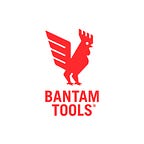Chris Gammell: Using Desktop CNC Machining to Prototype PCBs Faster
When we think about electronics projects, talented electrical engineer Chris Gammell immediately comes to mind. His passion for electronics drives him to not only continue to explore new areas of electronics for himself but also to help others hone their skills as well. You may know him from The Amp Hour podcast, his Contextual Electronics courses, or Analog Life, LLC. Back in October 2019, he joined the Bantam Tools remote residency to prototype breakout boards and learn more about designing RF antenna PCBs. We caught up with him to chat about his experience.
How did you get started with electronics and CNC machining?
I got really interested in machining a couple of years ago from “The Guerrilla Guide to Machining.” It’s a manifesto on the benefits of CNC machining over 3D printing and shares a range of tips and tricks to get started. I dove in and bought a Taig mill with a CNC kit and started learning how to use CAM software.
After two years of learning and marginal output, I ended up moving to a smaller place and sold my mill. This gave me great context for how difficult CAM could be and made me appreciate the simplicity of the Bantam Tools Desktop Milling Machine Software, especially when it comes to PCB milling. I was reintroduced to CNC machines during Joe FitzPatrick’s Securing Hardware workshops at the Black Hat security conferences, and that got me interested in milling again.
Tell us more about the breakout boards you milled during your residency.
I was milling small breakout boards and antennas. I had a concurrent interest to learn more about radio frequency (RF). I was able to use the Bantam Tools Desktop PCB Milling Machine to try different antenna shapes and measure them on the Vector Network Analyzer (VNA) that I had on loan at the time. It was helpful to be able to try different things without having to wait for PCBs to return from China, which really increased my iteration cycles.
What’s your favorite feature of the Bantam Tools mill? What has the mill enabled you to do that you previously couldn’t?
I think the integrated CAM portion is a really useful feature, especially for electrical engineers. I have access to a wide range of precision milling machines, but I never consider using them. Having to go through the traditional CAM software toolchains goes over my head. I think being able to drop Gerbers into the Bantam Tools software is something that makes milling a lot more approachable.
Aside from the mill, what are three tools you can’t live without? Why?
KiCad. This is open source software used to design circuit boards. I’m a huge fan and supporter of this project. I was able to easily create and iterate on PCB and antenna designs using this software.
The Digilent Analog Discovery 2. It’s a versatile piece of test equipment that is not only small, but it’s portable. I’m able to carry a power supply, scope, logic analyzer, and more in my backpack, along with my laptop.
A good microscope. Components keep getting smaller, and microscopes allow me to not only put them onto PCBs, but also double check my soldering skills and make sure that parts are connected properly.
What are three tips you’d offer other electrical engineers using the Bantam Tools Desktop PCB Milling Machine for the first time?
- Use good design rules so that your PCB Gerber files are imported properly. If you don’t understand how wide the toolpaths will be, you’ll get weird results on the output from the Bantam Tools software that don’t match what you want it to do.
- Learn how different end mills cut through material. This will help you later on if you’re troubleshooting a cut or design.
- At the beginning, copper pours are a bit unintuitive. Personally, I design copper pours into all of my designs. But since the mill is doing isolation cuts, it’s usually better to route signals from point to point, including power and ground. When you learn more about how the shapes translate to actual cuts on the mill, you can start playing around with copper pours.
Chris Gammell is an electrical engineer, educator, co-host of The Amp Hour podcast, and a consultant at Analog Life in Chicago. At Analog Life, he works with clients to design projects ranging from learning platforms to connected sensor networks.
Follow Bantam Tools on Instagram, Facebook, Twitter, and be sure to subscribe to the Bantam Tools mailing list to receive more content like this.
